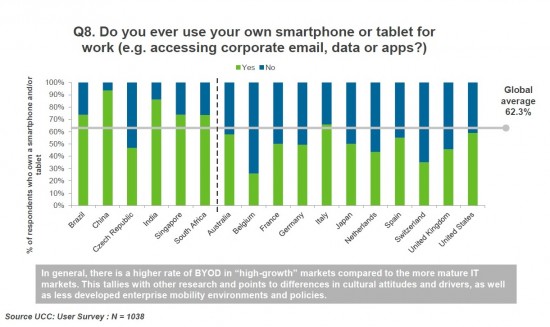This is the fourth post in a series from Dimension Data and Cisco Channels looking at user adoption and integration of unified communications and collaboration (UC&C) solutions. Findings stem from Dimension Data’s 2013 Global UC&C Survey, developed with ICT researcher Ovum and featuring responses from more than 2,700 participants in 18 countries across 20 vertical industries.
In a previous blog post based on this research, we heard about evidence that the implementation of some technologies is no longer the end goal in UC&C but have become a ‘ticket to the game’. In this most recent blog, Nagi Kasinadhuni, general manager converged communications and customer interaction solutions, has expanded on those ideas with his opinion on where this will lead clients in the future.
According to Kasinadhuni, when studying the UC&C study closely, some interesting nuances can be seen. In general, his opinion is that the decision maker survey is predictable, except in areas or markets where the adoption of bring your own device (BYOD) is high. High growth markets also tend to have higher BYOD adoption rates as opposed to more mature markets.
 However, in the End User survey, he says he sees many responses that seem counter-intuitive and challenge expectations.
However, in the End User survey, he says he sees many responses that seem counter-intuitive and challenge expectations.
These include a particular area that, in Kasinadhuni’s opinion, is of particular interest: How employers view devices on their corporate network versus how employees view those same devices.
“The benefits around UC&C and BYOD are perceived differently for the end user or the client. The client looks at things like productivity and cost savings as primary motivations for embarking on these technologies. But the end user really looks at these as a ‘hygiene factor.’ I don’t consider myself more productive because I am using a laptop or instant messaging (IM). It is a tick in the box that I just expect to be there,” said Kasinadhuni.
He went on to add, “When it comes to BYOD, we found some interesting things in this research, in my opinion. Users are not necessarily comfortable with corporate restrictions placed on their personal devices. If they are using their smartphones to access corporate email, and the corporation wipes the device, what happens to their personal content on the phone? With a higher awareness of privacy given the global events in the news, employees are more sensitive to personal privacy than a year ago”
“You would think that if users were given corporate devices they would easily accept that they wouldn’t use those devices for personal use, but we didn’t see that in the research. We saw users expect to use the corporate device for personal use. In my opinion they see this as making them more productive and corporations have to embrace that approach. Companies must get comfortable with employees using corporate devices for personal use and they must be open to provide those devices even as there will be a section of employees who will bring their personal devices,” opined Kasinadhuni.
In short, according to Kasinadhuni, corporations still look at certain technologies, such as IM, as being strictly about improving productivity or reducing cost. However, employees, and clients, don’t look at things like IM as making them more productive. Those technologies are still only a “ticket to the game.”
“Technology providers need to understand that there are two sets of stakeholders within an organization – both of whom need be convinced, using completely different approaches. The business/ IT who are the traditional buyers of technology; and now, a new set of stakeholders, who are increasingly determining the success of any IT implementation – the end users. While the dollars may come from the organization, the actual benefits of productivity, agility and competitiveness come from the end users,” he said.
Finally, in his opinion, the three key takeaways from this particular bit of research for partners are:
- The culture of a company overpowers everything. If the employees are resistant to using their personal devices on the corporate network, but OK with using corporate devices for a mix of work and personal use, then you should not spend time and money fighting that approach.
- Don’t let your competition dictate how you behave. If someone else sets the precedent that you have to follow, then you can’t differentiate yourself any more. You have to play by rules already set by a competitor.
- The voice of the end user is also the voice of your client. Realize that what you’re hearing from your own end users is what they are hearing from your clients.
Check back with Cisco and Dimension Data next month for a continued discussion on this research. In the meantime, learn more about Dimension Data’s 2013 Global UC&C study. And don’t forget to join the conversation; leave a comment below or talk to us on Dimension Data’s UC&C Facebook page.
CONNECT WITH US